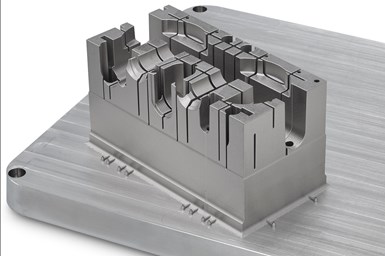Erofio Group 3D Prints First Part on GE Additive Concept Laser M Line
Mold core successfully additively manufactured on first attempt, using hot work tool steel, in a six-day test build.

Additively manufactured Mold Core using hot-work tool steel, printed on a GE Additive Concept Laser M Line system.
Portugal’s Erofio Group – an industrial moldmaker and long-standing user of GE Additive’s DMLM laser technology — recently used the GE Additive Concept Laser M Line to additively manufacture a mold core during a six-day test build.
Less than three months since receiving and installing an M Line system at its moldmaking facility in Batalha, central Portugal, a team led by Erofio Group’s metal additive manufacturing (AM) leader, Luís Santos, successfully 3D printed its first mold core.
The core was manufactured using M300 hot work tool steel — a material often used for the production of injection molding and die casting tool inserts with conformal cooling, as well as functional components. The core contains more than eight independent, internal conformal cooling channels, stretching over eight meters in length and between five to eight millimeters in diameter.
Additively manufacturing the part afforded the team the design freedom to enable conformal cooling to create a more efficient heat exchange, the company says. This improved cooling will increase the overall plastic injection process productivity through decreased cooling cycle time and warpage, and the improvement of the injected plastic part aesthetics. In addition to the benefits of geometric freedom on the design of inner channels, using AM reduced finishing requirements by 90%.
Another advantage, when compared to conventional manufacturing processes, was a reduction in the total manufacturing time (from powder to mold assembly) by 30%, the company says.

Following remote optimization support from the GE Additive team in Lichtenfels, the part was successfully printed on its first attempt, over a six-day period in May 2021.
Related Content
-
The Connector Conundrum: 3D Printed Mold Tooling’s Role in Innovation
ReelView Fishing faced an electronics obstacle in the development of its new technology for underwater video. Additive manufacturing for moldmaking allowed for the speed necessary to iterate to a solution. How inventors and invention will benefit from new ways of obtaining production-ready tooling.
-
3D Printed Mold Tooling Advances in Performance With Proprietary Resin
Material improvements offer turnkey production and cost trimming with 3D printed mold tooling. A new, proprietary resin addresses the current limitations associated with 3D printing in polymer.
-
Video: Mold Base for Product Development With 3D Printed Molds
Alba Enterprises created a mold base to match the needs and pacing of product iteration using mold tooling made via additive manufacturing














